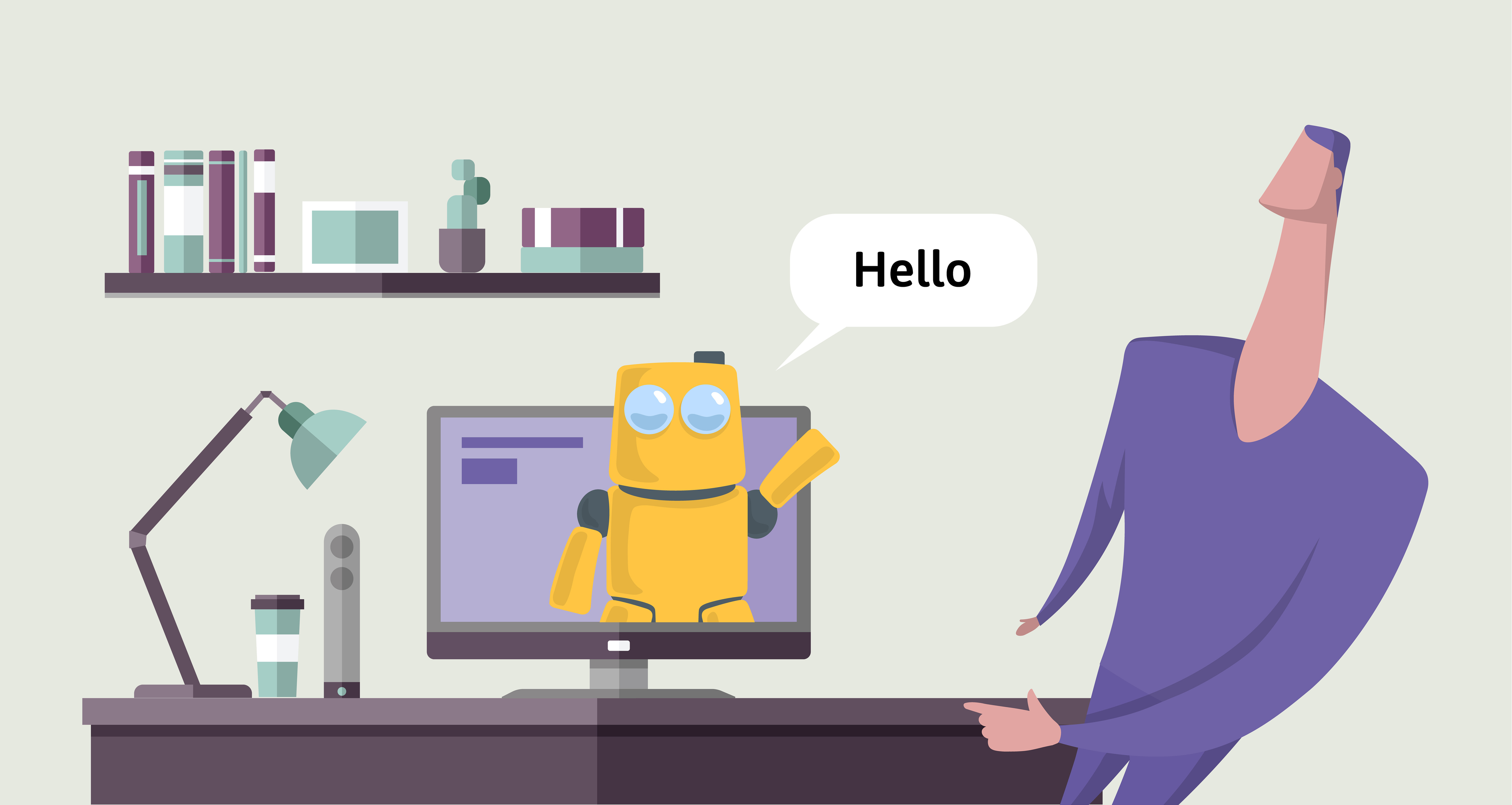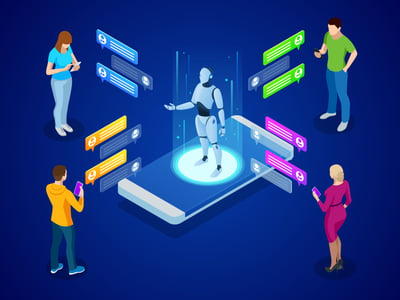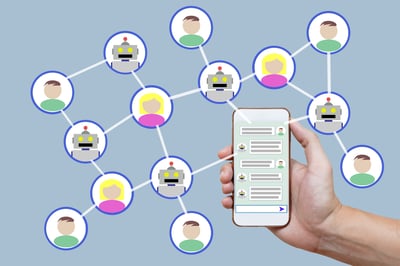April 3, 2019
 by Rebecca Reynoso / April 3, 2019
by Rebecca Reynoso / April 3, 2019

Have you encountered a chatbot in place of a human customer service representative (CSR) on a website you frequent?
It’d be surprising if you hadn’t. Some websites are no stranger to chatbots, especially tech sites that rely on chatbot CSRs to field questions from people browsing their webpage. However, AI chatbots are becoming more prevalent outside of tech-only industries.
8 tips about using chatbots:
Tech and non-tech industries alike have benefitted from chatbot integration on their websites. Chatbots assist with a variety of things, such as general inquiries, FAQ responses, or directing a person from speaking with a chatbot CSR to a human representative.
To find out more, we asked eight business professionals from various industries how their company utilizes chatbots, what type of assistance their chatbots provide to customers, and tips on using chatbots in the workplace to benefit employees and customers alike.
“We provide companies with Facebook Messenger-powered marketing and communications tools. One of our signature products is Airy Intelligent Automations. This feature enables companies to automate responses to frequently asked questions and seamlessly passes off complex queries to live agents.
We make use of our Intelligent Automations on our website. At the moment, we mostly use this feature solely for customer care. Website visitors are able to easily navigate a menu, which enables them to sign up for our newsletter, view our top product features, or get in touch with customer service."
- Mason Mitchel, Communications & Content Marketing Manager at Airy
“We added ShapeBot, a conversational chatbot powered by Drift, to our marketing website and blog. ShapeBot greets every visitor to our website by using personalized and customized responses based on what page they enter on and if they've visited before.
Our chatbot answers common queries on anything from pricing to details about our product. If a visitor is reading our blog, ShapeBot will offer other helpful resources that help inform the visitor and guide them further down our sales funnel. Finally, potential customers can get real-time answers to their questions from ShapeBot, or they can be quickly connected to a member of our team if need be.
Two of our largest sales in 2018 were from people who first interacted with us through ShapeBot. They received a few answers via our custom messaging flows and seamlessly booked a demo with our sales team during their conversation with ShapeBot.”
- Jon Davis, Founder of Shape Integrated Software
“Chatbots have been an essential digital tool that I utilize on social media for my real estate company, KLR International Realty, based out of Louisville, KY. We have utilized a chatbot questionnaire to gather basic information on the needs of a new follower reaching out. By going through a series of questions that require simple answers set up through a chatbot, it gives us an idea of what the client is looking for in their purchasing requirements.
We also utilize chatbots for live event announcements and reminders. With the sensitivity of clientele we have, live educational events are an integral part of the success of our business. During live events, we provide information on how non-US citizens can purchase a home in the US with financing. We teach them about their financing options depending on their immigration status. With chatbots, we are able to send out a mass broadcast to our following by announcing the events and giving reminders about the event. It also allows people to RSVP in advance.”
- Sandi L. Lanham, Partner at KLR International Realty
“Paychex introduced Paychex Flex Assistant in December 2018 to enhance the customer experience and drive efficiencies for our clients and their employees within our application, Paychex Flex(r). Paychex Flex assistant currently answers more than 100 questions covering the breadth and depth of our entire HCM suite. This includes account maintenance, time and attendance, payroll, retirement, benefits, and much more.
We initially built the bot to answer the most frequently asked questions of our front-line service providers. They're interacting with hundreds of thousands of clients every day, and the tenor of all of those interactions – both phone and email – informed the initial questions Paychex Flex Assistant could confidently answer.
If the bot, which is presented very clearly as such, fails to successfully answer a user's question in two attempts, they will be automatically connected with a live agent in real time and within the same chat to get the answer. It is our goal for any session started in Paychex Flex Assistant to end in a successful result with a satisfied customer.”
- Nathan Shapiro, Senior Product Manager at Paychex
“Our company has developed a chatbot for vacation planning in the SharePoint intranet. We use it for internal purposes, making vacation planning easier for our employees.
The chatbot was trained to support natural human conversation and can greet and check up on a user. When talking to the bot, an employee can ask it to book a new vacation, show or delete an already planned vacation, or display the number of available vacation days in general. For the sake of convenience, the chatbot is also integrated with the two messengers that are most popular among the staff – Skype and Telegram – and can be reached from outside the intranet.”
- Boris Shiklo, Chief Technology Officer at ScienceSoft
“Solodev developed a chatbot for users on our website and also deployed it in the backend of our content management software. Site visitors can connect with our sales department with questions about the platform or with our support department to open support tickets.
Inside our software platform, users can ask questions and be directed to appropriate articles and documentation. Finally, we have a hybrid approach to our chatbot with live human support during office hours and AI driven support in off-hours.”
- Wes Marsh, Director of Digital Marketing at Solodev
“Our bot's sole purpose is to engage in general conversations. It doesn't pitch products or ask you about your business. It's a learning exercise that helps push the limits of what we can do as well as a proof point about what is easy or difficult for today's bots. While it's not a very “smart” bot, it improves every few weeks with each update. Our somewhat-silly bot also provides a bit of entertainment to the thousands of people who are using it.
Once the bot becomes smart enough (in the next 6 months I'll add a custom neural network to it), we will incorporate it into our website along with some basic knowledge about our company for Q&A should anyone ask. But it will always be a general purpose chatbot first and foremost.”
- Alan Majer, Founder and CEO of Good Robot
“Our chatbot is multifunctional, from customer service to sales. Plus, it connects you to a live customer service agent. We have over 400 team members working in customer service, so it’s more of a forwarding service than an attempt to replace any of our CSRs or sales team members.
We've found that we receive all kinds of inquiries in the chatbot. It's almost replacing the contact form of olden times, as it serves as a catchall for inquiries.”
- Yaniv Masjedi, CMO at Nextiva

Chatbots are widely used as the first face a company puts forward. Typically, this comes in the form of canned responses to customer questions or by directing a customer to a blog post or page that contains the information they’re looking for. Despite this, chatbots have continued to expand into areas such as helping customers build rapport with a company and helping employees with ease of functionality internally and externally.
Want to learn more about chatbots? Read up on Facebook chatbots and what kind exist today as well as some intriguing chatbot statistics for 2019!
Rebecca Reynoso is the former Sr. Editor and Guest Post Program Manager at G2. She holds two degrees in English, a BA from the University of Illinois-Chicago and an MA from DePaul University. Prior to working in tech, Rebecca taught English composition at a few colleges and universities in Chicago. Outside of G2, Rebecca freelance edits sales blogs and writes tech content. She has been editing professionally since 2013 and is a member of the American Copy Editors Society (ACES).
It’s the battle of the bots.
 by Shay Berman
by Shay Berman
With the popularity of online shopping and regular growth of the e-commerce market, demand for...
 by Rebecca Reynoso
by Rebecca Reynoso
The use of chatbot technology has risen throughout the 2010s, yet as early as the 1960s,...
 by Rebecca Reynoso
by Rebecca Reynoso
It’s the battle of the bots.
 by Shay Berman
by Shay Berman
With the popularity of online shopping and regular growth of the e-commerce market, demand for...
 by Rebecca Reynoso
by Rebecca Reynoso


